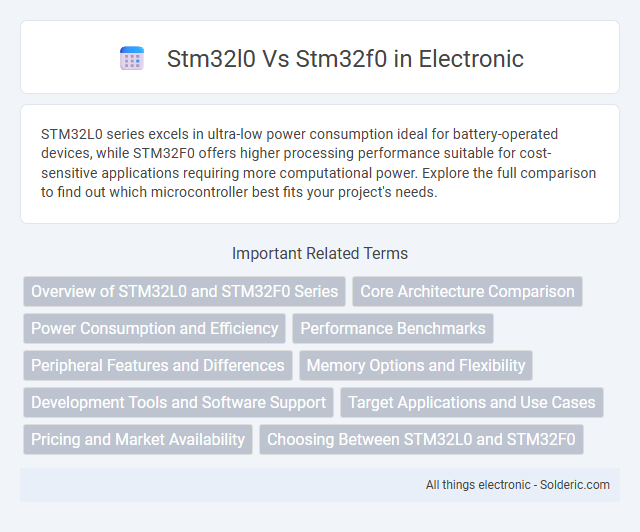STM32L0 series excels in ultra-low power consumption ideal for battery-operated devices, while STM32F0 offers higher processing performance suitable for cost-sensitive applications requiring more computational power. Explore the full comparison to find out which microcontroller best fits your project's needs.
Comparison Table
| Feature | STM32L0 Series | STM32F0 Series |
|---|---|---|
| Core | ARM Cortex-M0+ (ultra-low power) | ARM Cortex-M0 (performance-oriented) |
| Operating Frequency | Up to 32 MHz | Up to 48 MHz |
| Power Consumption | Ultra-low power, ideal for battery-operated devices | Moderate power consumption, optimized for cost-effective applications |
| Flash Memory | Up to 192 KB | Up to 128 KB |
| RAM | Up to 20 KB | Up to 8 KB |
| Low Power Modes | Multiple ultra-low power modes for energy saving | Basic low power modes |
| Peripherals | RTC, LCD controller, USB, ADC, DAC, comparators | USB, ADC, DAC, timers, USART, SPI, I2C |
| Package Options | Wide range including ultra-small packages (QFN, UFQFPN) | Various packages (LQFP, QFN, UFQFPN) |
| Target Applications | Wearables, IoT, energy harvesting, portable medical | Cost-sensitive consumer electronics, simple industrial control |
| Price | Generally higher due to low power features | Lower cost, budget-friendly MCUs |
Overview of STM32L0 and STM32F0 Series
The STM32L0 series features ultra-low-power ARM Cortex-M0+ cores, optimized for energy efficiency and extended battery life in IoT and wearable applications. The STM32F0 series utilizes ARM Cortex-M0 cores, prioritizing cost-effectiveness and performance for entry-level devices requiring moderate power consumption. Both series offer a range of integrated peripherals, but STM32L0 emphasizes low-power modes, while STM32F0 targets a balance between performance and integration complexity.
Core Architecture Comparison
STM32L0 series features an Arm Cortex-M0+ core optimized for ultra-low power consumption, running up to 32 MHz, whereas STM32F0 series uses an Arm Cortex-M0 core with clock speeds up to 48 MHz, emphasizing performance and cost-efficiency. The Cortex-M0+ core in STM32L0 offers enhanced power efficiency through improvements like a single-cycle I/O port and a lower power sleep mode. STM32F0's Cortex-M0 core delivers higher processing throughput, making it suitable for real-time control applications requiring faster execution.
Power Consumption and Efficiency
STM32L0 series microcontrollers deliver significantly lower power consumption with ultra-low power modes ideal for battery-operated applications, featuring consumption as low as 150 nA in standby. STM32F0 series offers moderate efficiency with active mode current typically higher, around several milliamps due to its focus on cost-effective performance rather than extreme power savings. Your choice depends on optimal energy efficiency needs versus performance requirements, with STM32L0 excelling in low-power scenarios.
Performance Benchmarks
STM32L0 series offers ultra-low power consumption with Cortex-M0+ cores running up to 32 MHz, delivering efficient performance ideal for energy-sensitive applications. STM32F0 series features Cortex-M0 cores operating up to 48 MHz, providing higher raw processing power and faster execution for performance-critical tasks. Your choice depends on whether power efficiency or computing speed takes priority in your embedded design.
Peripheral Features and Differences
STM32L0 series offers ultra-low-power features ideal for battery-operated devices, with advanced peripherals such as LCD drivers, comparators, and capacitive touch sensing modules, whereas STM32F0 focuses on higher performance with peripherals like CRC calculation units, advanced timers, and more communication interfaces including CAN and USB. STM32L0 integrates power-efficient analog peripherals optimized for energy-saving applications, while STM32F0 provides more comprehensive connectivity options suitable for industrial applications. Your choice depends on whether low power consumption or richer peripheral sets for communication and processing performance are prioritized.
Memory Options and Flexibility
The STM32L0 series offers a wider range of memory options, including up to 192 KB of Flash and 20 KB of RAM, optimized for ultra-low-power applications, whereas the STM32F0 series provides up to 64 KB of Flash and 8 KB of RAM, targeting cost-sensitive, general-purpose applications. STM32L0 devices support flexible memory configurations through EEPROM emulation and low-power modes to extend application durability, while STM32F0 focuses on faster execution with limited memory flexibility. Memory architecture in STM32L0 enhances system reliability and efficiency for battery-operated devices, in contrast to STM32F0's balanced performance for basic control tasks.
Development Tools and Software Support
The STM32L0 series offers extensive development tools including STM32CubeL0, which provides low-power middleware and HAL libraries tailored for energy-efficient applications. STM32F0 benefits from STM32CubeF0 and a wide range of integrated development environments (IDEs) like Keil, IAR, and STM32CubeIDE, ensuring broad software compatibility for cost-sensitive projects. Your development experience is enhanced by the STM32Cube ecosystem, which supports both series with code generation, real-time debugging, and firmware examples for rapid prototyping.
Target Applications and Use Cases
STM32L0 microcontrollers excel in ultra-low-power applications such as wearable devices, energy-harvesting sensors, and portable medical instruments, making them ideal for battery-operated and energy-sensitive designs. STM32F0 series targets cost-sensitive industrial and consumer applications requiring moderate processing power and real-time control, such as motor control, home appliances, and basic user interfaces. Your choice depends on prioritizing power efficiency with STM32L0 or cost-effectiveness and performance with STM32F0 for general-purpose embedded solutions.
Pricing and Market Availability
The STM32L0 series typically offers lower pricing due to its ultra-low-power design, making it an attractive option for cost-sensitive, energy-efficient applications. The STM32F0 series is widely available and often chosen for general-purpose tasks, priced slightly higher because of its broader feature set and higher performance. Market availability for both series is robust, with STM32F0 having a larger ecosystem and more extensive distributor support globally.
Choosing Between STM32L0 and STM32F0
Choosing between STM32L0 and STM32F0 microcontrollers depends on power efficiency and application requirements. STM32L0 series excels in ultra-low-power consumption, ideal for battery-operated and energy-sensitive devices, while STM32F0 offers higher performance with more processing power and peripherals suitable for cost-effective, general-purpose applications. Evaluate factors such as power budget, processing speed, peripheral set, and target application domain to select the optimal STM32 family.
stm32l0 vs stm32f0 Infographic

 solderic.com
solderic.com